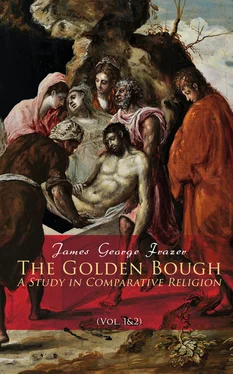James George Frazer
The Golden Bough: A Study in Comparative Religion (Vol. 1&2)
Complete Edition
e-artnow, 2020
Contact: info@e-artnow.org
EAN: 4064066398996
Volume 1 Volume 1 Table of Contents Chapter I. The King Of The Wood. § 1.—The Arician Grove. § 2.—Primitive man and the supernatural. § 3.—Incarnate gods. § 4.—Tree-worship. § 5.—Tree-worship in antiquity. Chapter II. The Perils Of The Soul. § 1.—Royal and priestly taboos. § 2.—The nature of the soul. § 3.—Royal and priestly taboos (continued) . Chapter III. Killing The God. § 1.—Killing the divine king. § 2.—Killing the tree-spirit. § 3.—Carrying out Death. § 4.—Adonis. § 5.—Attis. § 6.—Osiris. § 7.—Dionysus. § 8.—Demeter and Proserpine. § 9.—Lityerses.
Volume 2
Table of Contents Table of Contents Volume 1 Volume 1 Table of Contents Chapter I. The King Of The Wood. § 1.—The Arician Grove. § 2.—Primitive man and the supernatural. § 3.—Incarnate gods. § 4.—Tree-worship. § 5.—Tree-worship in antiquity. Chapter II. The Perils Of The Soul. § 1.—Royal and priestly taboos. § 2.—The nature of the soul. § 3.—Royal and priestly taboos (continued) . Chapter III. Killing The God. § 1.—Killing the divine king. § 2.—Killing the tree-spirit. § 3.—Carrying out Death. § 4.—Adonis. § 5.—Attis. § 6.—Osiris. § 7.—Dionysus. § 8.—Demeter and Proserpine. § 9.—Lityerses. Volume 2
Chapter I. The King Of The Wood. Chapter I. The King Of The Wood. Table of Contents “The still glassy lake that sleeps Beneath Aricia's trees— Those trees in whose dim shadow The ghastly priest doth reign, The priest who slew the slayer, And shall himself be slain.” Macaulay.
§ 1.—The Arician Grove.
§ 2.—Primitive man and the supernatural.
§ 3.—Incarnate gods.
§ 4.—Tree-worship.
§ 5.—Tree-worship in antiquity.
Chapter II. The Perils Of The Soul.
§ 1.—Royal and priestly taboos.
§ 2.—The nature of the soul.
§ 3.—Royal and priestly taboos (continued) .
Chapter III. Killing The God.
§ 1.—Killing the divine king.
§ 2.—Killing the tree-spirit.
§ 3.—Carrying out Death.
§ 4.—Adonis.
§ 5.—Attis.
§ 6.—Osiris.
§ 7.—Dionysus.
§ 8.—Demeter and Proserpine.
§ 9.—Lityerses.
Chapter I. The King Of The Wood.
Table of Contents
“The still glassy lake that sleeps
Beneath Aricia's trees—
Those trees in whose dim shadow
The ghastly priest doth reign,
The priest who slew the slayer,
And shall himself be slain.”
Macaulay.
Table of Contents
Who does not know Turner's picture of the Golden Bough? The scene, suffused with the golden glow of imagination in which the divine mind of Turner steeped and transfigured even the fairest natural landscape, is a dream-like vision of the little woodland lake of Nemi, “Diana's Mirror,” as it was called by the ancients. No one who has seen that calm water, lapped in a green hollow of the Alban hills, can ever forget it. The two characteristic Italian villages which slumber on its banks, and the equally Italian palazzo whose terraced gardens descend steeply to the lake, hardly break the stillness and even the solitariness of the scene. Dian herself might still linger by this lonely shore, still haunt these woodlands wild.
In antiquity this sylvan landscape was the scene of a strange and recurring tragedy. On the northern shore of the lake, right under the precipitous cliffs on which the modern village of Nemi is perched, stood the sacred grove and sanctuary of Diana Nemorensis, or Diana of the Wood.2 The lake and the grove were sometimes known as the lake and grove of Aricia.3 But the town of Aricia (the modern La Riccia) was situated about three miles off, at the foot of the Alban Mount, and separated by a steep descent from the lake, which lies in a small crater-like hollow on the mountain side. In this sacred grove there grew a certain tree round which at any time of the day and probably far into the night a strange figure might be seen to prowl. In his hand he carried a drawn sword, and he kept peering warily about him as if every instant he expected to be set upon by an enemy.4 He was a priest and a murderer; and the man for whom he looked was sooner or later to murder him and hold the priesthood in his stead. Such was the rule of the sanctuary. A candidate for the priesthood could only succeed to office by slaying the priest, and having slain him he held office till he was himself slain by a stronger or a craftier.
This strange rule has no parallel in classical antiquity, and cannot be explained from it. To find an explanation we must go farther afield. No one will probably deny that such a custom savours of a barbarous age and, surviving into imperial times, stands out in striking isolation from the polished Italian society of the day, like a primeval rock rising from a smooth-shaven lawn. It is the very rudeness and barbarity of the custom which allow us a hope of explaining it. For recent researches into the early history of man have revealed the essential similarity with which, under many superficial differences, the human mind has elaborated its first crude philosophy of life. Accordingly if we can show that a barbarous custom, like that of the priesthood of Nemi, has existed elsewhere; if we can detect the motives which led to its institution; if we can prove that these motives have operated widely, perhaps universally, in human society, producing in varied circumstances a variety of institutions specifically different but generically alike; if we can show, lastly, that these very motives, with some of their derivative institutions, were actually at work in classical antiquity; then we may fairly infer that at a remoter age the same motives gave birth to the priesthood of Nemi. Such an inference, in default of direct evidence as to how the priesthood did actually arise, can never amount to demonstration. But it will be more or less probable according to the degree of completeness with which it fulfils the conditions indicated above. The object of this book is, by meeting these conditions, to offer a fairly probable explanation of the priesthood of Nemi.
I begin by setting forth the few facts and legends which have come down to us on the subject. According to one story the worship of Diana at Nemi was instituted by Orestes, who, after killing Thoas, King of the Tauric Chersonese (the Crimea), fled with his sister to Italy, bringing with him the image of the Tauric Diana. The bloody ritual which legend ascribed to that goddess is familiar to classical readers; it is said that every stranger who landed on the shore was sacrificed on her altar. But transported to Italy, the rite assumed a milder form. Within the sanctuary at Nemi grew a certain tree of which no branch might be broken. Only a runaway slave was allowed to break off, if he could, one of its boughs. Success in the attempt entitled him to fight the priest in single combat, and if he slew him he reigned in his stead with the title of King of the Wood (Rex Nemorensis). Tradition averred that the fateful branch was that Golden Bough which, at the Sibyl's bidding, Aeneas plucked before he essayed the perilous journey to the world of the dead. The flight of the slave represented, it was said, the flight of Orestes; his combat with the priest was a reminiscence of the human sacrifices once offered to the Tauric Diana. This rule of succession by the sword was observed down to imperial times; for amongst his other freaks Caligula, thinking that the priest of Nemi had held office too long, hired a more stalwart ruffian to slay him.5
Читать дальше












